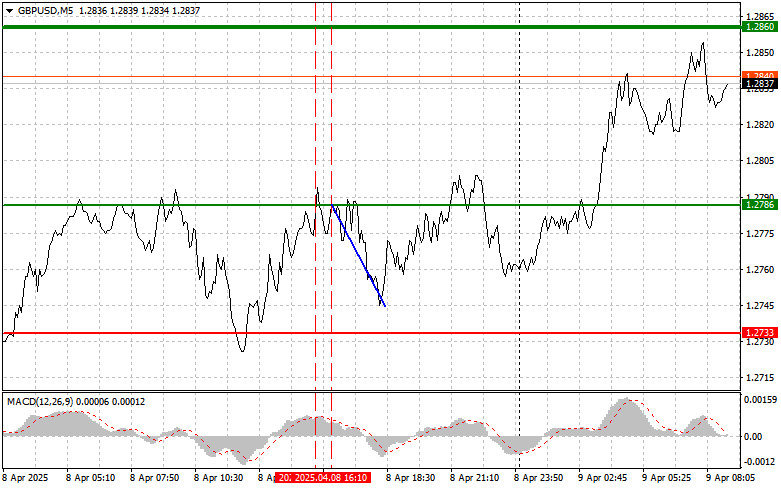Analysis of Trades and Trading Tips for the British Pound
The test of the 1.2786 price level occurred when the MACD indicator had already moved significantly above the zero line, which limited the pair's upside potential. The second test of 1.2786, when the MACD was in the overbought area, allowed scenario #2 for a sell trade to be executed, resulting in a decline of over 40 pips.
Following news that the UK Chancellor would hold talks with senior officials regarding the tariff crisis, the pound strengthened. However, the GBP/USD pair's growth was mainly driven by renewed speculation that the U.S. economy could soon begin showing signs of a recession, weakening the dollar's position.
Today, during the first half of the day, the summary and minutes of the Bank of England's Financial Policy Committee meeting will be published. Close attention must be paid to the details of the vote on interest rates and any indications regarding future policy. Markets will analyze the tone of the statements for signs of how confident committee members are in reducing inflation to the 2% target. Discussions around the impact of global economic factors and the potential effects of U.S. tariffs will also be reviewed. Investors are hoping for clarity on the timing of possible monetary policy easing. Any signals suggesting the Bank of England is ready to act independently of the Federal Reserve or the European Central Bank will have significant implications for the pound's exchange rate.
For intraday strategy, I will focus primarily on Scenarios #1 and #2.
Buy Signal
Scenario #1:
Today, I plan to buy the pound upon reaching the entry point around 1.2857 (green line on the chart), targeting a rise to 1.2924 (thicker green line). Around 1.2924, I plan to exit the buy trades and open sell trades in the opposite direction (expecting a 30–35 pip pullback). Today's rise in the pound could continue as part of the morning correction.
Important: Before buying, ensure that the MACD indicator is above the zero line and beginning to rise.
Scenario #2:
I also plan to buy the pound today if there are two consecutive tests of the 1.2820 level while the MACD is in the oversold area. This will limit the pair's downside potential and trigger an upward reversal. A rise toward the opposite levels of 1.2857 and 1.2924 can be expected.
Sell Signal
Scenario #1:
I plan to sell the pound after the price breaks below the 1.2820 level (red line on the chart), which could lead to a rapid decline. The key target for sellers will be 1.2761, where I plan to exit the sell trades and immediately open buys in the opposite direction (expecting a 20–25 pip move in the opposite direction). Caution is advised when selling the pound—enter as high as possible.
Important: Before selling, ensure that the MACD is below the zero line and just beginning to fall from it.
Scenario #2:
I also plan to sell the pound today if there are two consecutive tests of the 1.2857 level while the MACD is in the overbought area. This will limit the upside potential and trigger a downward reversal. A decline toward the opposite levels of 1.2820 and 1.2761 can be expected.
What's on the Chart:
- The thin green line represents the entry price where the trading instrument can be bought.
- The thick green line indicates the expected price level where a Take Profit order can be placed, or profits can be manually secured, as further price growth above this level is unlikely.
- The thin red line represents the entry price where the trading instrument can be sold.
- The thick red line indicates the expected price level where a Take Profit order can be placed, or profits can be manually secured, as further price decline below this level is unlikely.
- The MACD indicator should be used to assess overbought and oversold zones when entering the market.
Important Notes:
- Beginner Forex traders should exercise extreme caution when making market entry decisions. It is advisable to stay out of the market before the release of important fundamental reports to avoid exposure to sharp price fluctuations. If you choose to trade during news releases, always use stop-loss orders to minimize potential losses. Trading without stop-loss orders can quickly wipe out your entire deposit, especially if you neglect money management principles and trade with high volumes.
- Remember, successful trading requires a well-defined trading plan, similar to the one outlined above. Making impulsive trading decisions based on the current market situation is a losing strategy for intraday traders.














